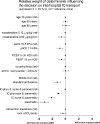Decision making in interhospital transport of critically ill patients: national questionnaire survey among critical care physicians
- PMID: 18283432
- PMCID: PMC2480595
- DOI: 10.1007/s00134-008-1023-x
Decision making in interhospital transport of critically ill patients: national questionnaire survey among critical care physicians
Abstract
Objective: This study assessed the relative importance of clinical and transport-related factors in physicians' decision-making regarding the interhospital transport of critically ill patients.
Methods: The medical heads of all 95 ICUs in The Netherlands were surveyed with a questionnaire using 16 case vignettes to evaluate preferences for transportability; 78 physicians (82%) participated. The vignettes varied in eight factors with regard to severity of illness and transport conditions. Their relative weights were calculated for each level of the factors by conjoint analysis and expressed in beta. The reference value (beta = 0) was defined as the optimal conditions for critical care transport; a negative beta indicated preference against transportability.
Results: The type of escorting personnel (paramedic only: beta = -3.1) and transport facilities (standard ambulance beta = -1.21) had the greatest negative effect on preference for transportability. Determinants reflecting severity of illness were of relative minor importance (dose of noradrenaline beta = -0.6, arterial oxygenation beta = -0.8, level of peep beta = -0.6). Age, cardiac arrhythmia, and the indication for transport had no significant effect.
Conclusions: Escorting personnel and transport facilities in interhospital transport were considered as most important by intensive care physicians in determining transportability. When these factors are optimal, even severely critically ill patients are considered able to undergo transport. Further clinical research should tailor transport conditions to optimize the use of expensive resources in those inevitable road trips.
Figures
References
-
- Duke GJ, Green JV. Outcome of critically ill patients undergoing interhospital transfer. Med J Aust. 2001;174:122–125. - PubMed
MeSH terms
LinkOut - more resources
Full Text Sources
Other Literature Sources


